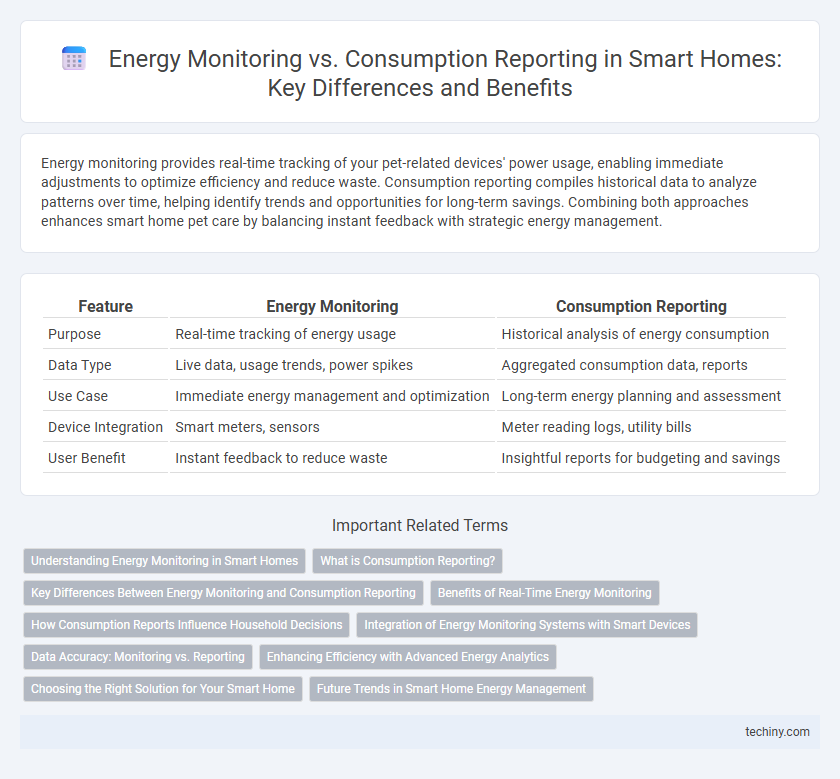Energy monitoring provides real-time tracking of your pet-related devices' power usage, enabling immediate adjustments to optimize efficiency and reduce waste. Consumption reporting compiles historical data to analyze patterns over time, helping identify trends and opportunities for long-term savings. Combining both approaches enhances smart home pet care by balancing instant feedback with strategic energy management.
Table of Comparison
| Feature | Energy Monitoring | Consumption Reporting |
|---|---|---|
| Purpose | Real-time tracking of energy usage | Historical analysis of energy consumption |
| Data Type | Live data, usage trends, power spikes | Aggregated consumption data, reports |
| Use Case | Immediate energy management and optimization | Long-term energy planning and assessment |
| Device Integration | Smart meters, sensors | Meter reading logs, utility bills |
| User Benefit | Instant feedback to reduce waste | Insightful reports for budgeting and savings |
Understanding Energy Monitoring in Smart Homes
Energy monitoring in smart homes involves real-time tracking of electrical usage through sensors and smart meters, enabling homeowners to identify energy patterns and inefficiencies instantly. Unlike consumption reporting, which provides historical data summaries, energy monitoring offers actionable insights for immediate energy management and cost reduction. Advanced systems integrate with home automation to optimize device performance, enhancing overall energy efficiency and sustainability.
What is Consumption Reporting?
Consumption reporting in smart home systems involves the detailed tracking and visualization of energy usage patterns over time, providing homeowners with insights into how much electricity each device or appliance consumes. This data is typically presented through user-friendly interfaces, enabling users to identify high-energy devices and optimize their usage to reduce overall consumption. By leveraging consumption reports, smart home technologies facilitate informed decision-making for energy efficiency and cost savings.
Key Differences Between Energy Monitoring and Consumption Reporting
Energy monitoring provides real-time data on electricity usage, allowing users to track and analyze energy flow instantaneously, whereas consumption reporting offers summarized insights based on historical energy data for past periods. Energy monitoring systems typically use smart sensors and IoT devices for continuous measurement, while consumption reports rely on aggregated readings from utility meters or smart meters. The key difference lies in immediacy and data granularity, with monitoring enabling proactive energy management and consumption reporting supporting trend analysis and billing verification.
Benefits of Real-Time Energy Monitoring
Real-time energy monitoring provides instantaneous data on electricity usage, enabling homeowners to identify inefficiencies and reduce waste immediately. This continuous insight helps optimize appliance performance, lower energy bills, and support sustainable living by minimizing carbon footprint. Unlike traditional consumption reporting, which offers historical data, real-time monitoring empowers proactive energy management and faster decision-making.
How Consumption Reports Influence Household Decisions
Consumption reports provide detailed insights into energy usage patterns, helping households identify peak consumption times and inefficient appliances. By analyzing these reports, homeowners can make informed decisions on adjusting usage habits or upgrading to energy-efficient devices, leading to cost savings and reduced environmental impact. This proactive approach enhances overall energy management and supports sustainable living practices.
Integration of Energy Monitoring Systems with Smart Devices
Energy monitoring systems integrated with smart devices enable real-time tracking of energy usage, optimizing consumption patterns for greater efficiency. Data collected from smart meters, thermostats, and appliances allows users to identify energy-intensive devices and adjust usage accordingly. Seamless integration supports automated responses, such as adjusting lighting or HVAC settings based on occupancy and energy demand, reducing overall consumption and costs.
Data Accuracy: Monitoring vs. Reporting
Energy monitoring systems in smart homes provide real-time data accuracy by continuously tracking electricity usage through sensors and smart meters, enabling immediate detection of anomalies and inefficiencies. Consumption reporting tools, however, compile historical data into periodic summaries, which may introduce delays and reduce precision in identifying short-term energy fluctuations. Accurate real-time monitoring is essential for optimizing energy management, while consumption reports serve as valuable tools for long-term trend analysis and cost forecasting.
Enhancing Efficiency with Advanced Energy Analytics
Energy monitoring provides real-time data on electricity usage, enabling precise tracking of consumption patterns and immediate identification of inefficiencies. Consumption reporting aggregates this data into comprehensive reports that reveal trends and support informed decision-making for energy savings. Combining advanced energy analytics with these tools enhances smart home efficiency by optimizing appliance use and reducing unnecessary power waste.
Choosing the Right Solution for Your Smart Home
Energy monitoring systems provide real-time data on electricity usage, enabling homeowners to identify high-consumption devices and optimize energy efficiency instantly. Consumption reporting tools analyze historical data to deliver comprehensive insights and trends over time, helping users make informed decisions about long-term energy management. Selecting the right solution depends on your smart home's complexity and goals: prioritize energy monitoring for immediate control and consumption reporting for strategic planning.
Future Trends in Smart Home Energy Management
Energy monitoring in smart homes leverages real-time data and AI algorithms to optimize consumption patterns, enabling precise control over appliances and reducing energy waste. Future trends emphasize integrating advanced sensors and machine learning to predict and adapt energy usage proactively, enhancing efficiency and cost savings. Consumption reporting continues to evolve with detailed analytics and user-friendly dashboards, empowering homeowners to make informed decisions and support sustainable living.
Energy Monitoring vs Consumption Reporting Infographic

 techiny.com
techiny.com